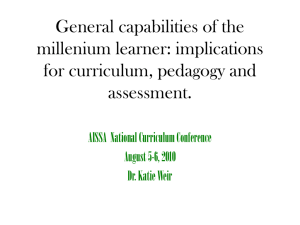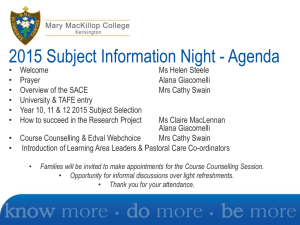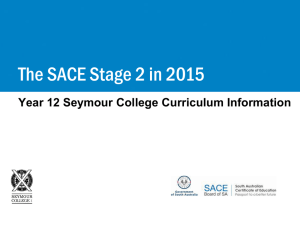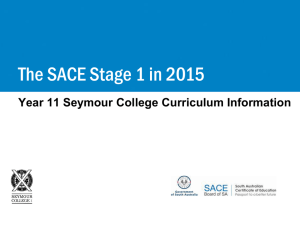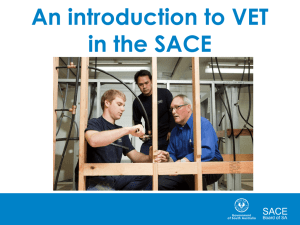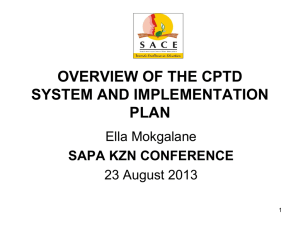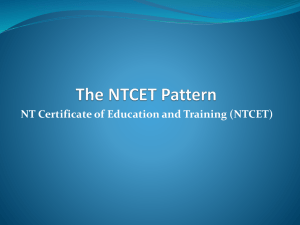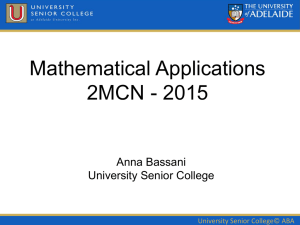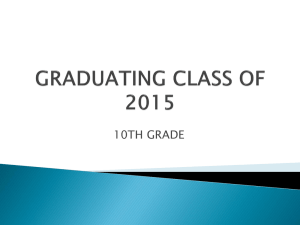Starting the SACE - Mount Compass Area School
advertisement
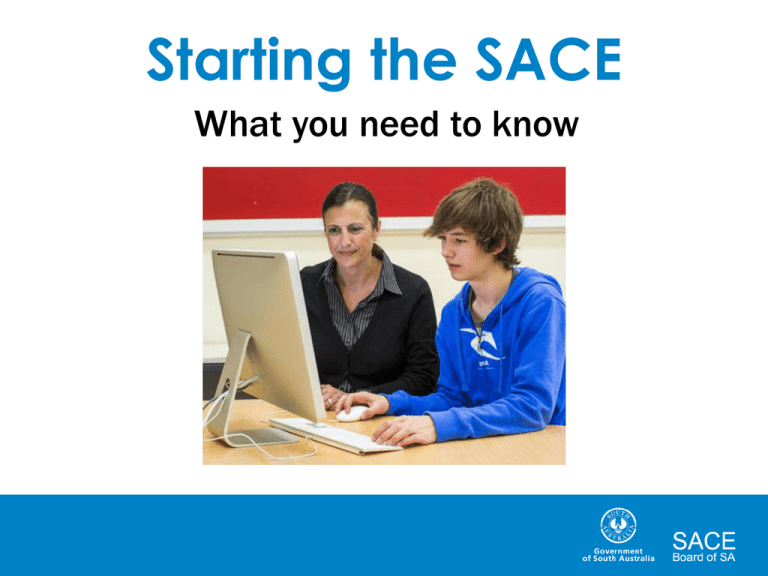
Starting the SACE What you need to know What is the SACE? What is the SACE? • SACE stands for South Australian Certificate of Education • A qualification for entry into universities and further training • Recognised nationally and internationally What is the SACE? By completing the SACE, students prepare for further learning, work, and life, by: • Building essential skills and knowledge • Making informed choices about future study and work, based on their strengths and interests • Gaining a certificate that gives them a head-start on their pathway beyond school Stage 1 and Stage 2 There are two ‘stages’ of the SACE: • Stage 1 is generally completed in Year 11 • Stage 2 is generally completed in Year 12 • This can vary between schools and students (e.g. many schools offer the Personal Learning Plan in Year 10) How the SACE works Capabilities Throughout the SACE, students build five key capabilities: – Communication – Citizenship – Learning – Personal Development – Work Learning through assessment • Each grade (from A to E) in each SACE subject has a ‘performance standard’, describing the type of work that will receive that grade • A student’s SACE work is assessed against these standards • The standards are the same around the state • They help students understand the reasons behind their grades, and how to improve Flexible pathways • The SACE is flexible, and caters for learning both in and outside school • Students can combine study and part-time work, a traineeship or school-based apprenticeship • Students can receive credit for SACE subjects, vocational education and training, community learning, and university studies Excellence The SACE assists students to: • develop capabilities needed for life and work in the twenty-first century • gain high level VET qualifications for workforce • gain entry into state, national and international universities Universities entered by SACE students National International Flinders University New York University University of Adelaide University of Oxford University of South Australia Yale University Australian National University National University of Singapore University of Melbourne University of Cambridge University of Sydney Princeton University SACE requirements SACE requirements • Students need 200 credits to achieve the SACE • Most 10-credit subjects are studied over one semester and most 20-credit subjects are studied over two semesters • Students need to achieve a C grade or higher for Stage 1 requirements and a C- grade or higher for Stage 2 requirements to achieve the SACE SACE Credits Stage 1 Stage 1 • Subjects are graded from A to E • All tasks are assessed by teachers at the school • Assessment is externally checked in mathematics, English and the Personal Learning Plan The Personal Learning Plan • Stage 1 subject worth 10 credits • C grade or higher is needed • At the start of the SACE – Year 10 or 11 • Identify strengths and interests • Set personal and learning goals • Gain skills for future study and employment – planning, research The Personal Learning Plan Helps students to: • Look at different career paths and options • Choose the right SACE subjects and study options for their future plans • Think about courses and activities outside school that will help them achieve their goals Stage 1 and/or Stage 2 requirements • Literacy and numeracy requirements must be met at Stage 1 or Stage 2 • Literacy – from a range of English subjects or courses (20 credits) • Numeracy – from a range of mathematics subjects or courses (10 credits). • Students must achieve at least a C grade at Stage 1 or a C- grade at Stage 2 Stage 2 Stage 2 • Subjects are graded from A+ to E- • 70% of subject assessments (e.g. assignments) will be assessed by the student’s teacher and moderated by the SACE Board • 30% of subject assessments (e.g. investigations) will be assessed externally by a SACE Board assessor Stage 2 To achieve Stage 2, students need to complete: • Stage 2 subjects and/or VET (60 credits) • Research Project (10 credits) Most students will complete subjects and courses worth more than 70 credits at Stage 2 The Research Project • All Stage 2 students study the Research Project • A chance to do in-depth research and study a topic that interests the student • Develop skills in planning, research, analysis and communication • Tertiary-style study; skills valued by employers The Research Project • Need to achieve a C- grade or higher • Worth 10 credits • Research Project B can be included as part of a student’s Australian Tertiary Admission Rank (ATAR) Additional choices • To complete the SACE, students can choose from a range of other Stage 1 or Stage 2 subjects or courses (90 credits) • Students must achieve a grade in these subjects or courses to gain the SACE Other subjects and courses Recognised learning The SACE recognises learning both in and outside school, for example: • Vocational Education and Training courses (VET) • University and TAFE courses • Community learning (such as the Duke of Edinburgh’s Award or volunteer work) Vocational Education and Training (VET) • If students prefer hands-on learning or work outside the classroom, they can earn SACE credits for a wide range of activities • Students can learn on-the-job skills while working towards both the SACE and a VET qualification • VET options are available at both Stage 1 and Stage 2 Further study The Australian Tertiary Admission Rank (ATAR) • A measure of a student’s overall achievement in the SACE compared with other students • Used by universities in the selection of school leavers for a place in university courses • Ranges from 0 to 99.95 • Calculated from university aggregate, based on 3 full-year Tertiary Admissions Subjects (TAS) plus one full-year TAS, or other studies recognised by the SACE Board and universities Applying for university in 2015 To be eligible, a student will need to have: • Completed the SACE • Gained an ATAR • Gained a university aggregate • Met any prerequisite subject requirements needed for the university course • Complied with rules regarding subject combinations and counting restrictions Applying for TAFE • TAFE SA recognises the SACE as meeting the Course Admission Requirements for most of its courses • It also considers a variety of other qualifications and experiences in its entry and selection processes • For the most up to date information on course admissions requirements, refer to the TAFE SA website: www.tafesa.edu.au More information on university and TAFE entry • Full details on university and TAFE entry from 2015 onward will be in the Tertiary Entrance 2014, 2015, 2016 booklet • The booklet is published by the South Australian Tertiary Admissions Centre (SATAC), and is provided to schools each year • Useful information about uni entry is also available at: www.satac.edu.au Individual circumstances Students with a disability • The SACE Board offers modified subjects at Stage 1 and Stage 2 for students with identified intellectual disabilities • A student studying a modified subject will gain credits towards the SACE but not a grade for the subject; instead successful achievement is recorded as ‘Completed’ • Any modified subjects a student has studied will be listed on their SACE certificate Special Provisions • Special provisions are available if a student has an illness, disability or unforeseen circumstance which significantly impacts their ability to participate in an assessment • If a student applies for special provisions they need to provide evidence of how this impacts their ability to access assessment conditions • More information is on the SACE website under Students and Families > Special Provisions Interstate/overseas/adult students • The SACE Board will grant status for equivalent learning in other areas • Information about meeting the requirements for interstate, adult and overseas students can be found on the SACE website under Students and Families Further information Achieve handbook • Copies of the Stage 2 edition of the SACE student handbook, Achieve, are available for all Year 11 students • This edition of the handbook contains useful information about the SACE and is designed to be used during course counselling • Parents are encouraged to read the handbook with students to discuss options and plans Further information • Visit the SACE website – particularly the Students and Families and Subjects sections: www.sace.sa.edu.au • Read a copy of the Achieve handbook, Stage 1 or Stage 2 edition • Talk to the teachers at your school


